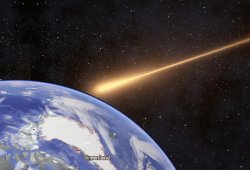
|
For thousands of years a meteorite crater 31 kilometers wide has been buried under the thick ice of northern Greenland. This size puts the Greenland crater among the largest craters ever found, and the discovery has excited scientists for other reasons also. Yet the discovery was almost accidental. NASA has long been engaged in a project to map Greenland's changing ice cover and as part of that effort ran an analysis of data collected between 1997 and 2014 by NASA’s Program for Arctic Regional Climate Assessment and Operation IceBridge. Researchers going through the data at the Faculty of Science at the University of Copenhagen came across evidence for what looked like a giant depression beneath the Hiawatha Glacier. Could that be a massive crater? The original data was not conclusive. |
|
|
However, the discovery was intriguing enough to warrant a more detailed topographical study. So in May 2016 a plane containing a next-generation radar system made three flights from Thule Air Base and returned with enough material to build a detailed picture of what lay beneath the Hiawatha Glacie - a very large and very well preserved circular crater. The confirmed size of this crater makes it number 25 on the list of the largest impact craters on Earth. So large an impact site required a substantial meteor of around a kilometer wide, and composed mainly of iron for that extra punch. Interestingly, there's evidence to back this up. The large iron meteorite named 'Cape York' (from the location where it was found) comes from Northern Greenland not far from our newly-discovered crater. (A 'meteorite' is a meteor, or part of a meteor, once it has come to earth.) This specimen was located in 1894 by Robert Peary, the famous American Navy Arctic explorer. The 'Cape York' is also known as Agpalilik meteorite by native Inuit who knew about the meteorite for centuries before Peary came across it. In fact the Inuit knew of several iron masses from space, the three largest being Ahnighito (the Tent), weighing 31 metric tons, the Woman, weighing 3 metric tons, and the Dog, weighing 400 kilograms. In 1963, a fourth major piece of the meteor turned up, discovered by Vagn F. Buchwald. This fragment, also known as the Man, weighs about 20 metric tons and is currently on the display at the Geological Museum in Copenhagen. So, has the impact crater of the meteor which created the Cape York meteorite finally been found? The scientists who discovered the Greenland crater believe so. In july 2016 the team visited the margin of Hiawatha Glacier and collected samples of sediments washed out from the glaciar. Of the three samples they collected, one sample came directly from the active floodplain. This contained quartz grains with characteristics consistent with a violent impact. Geochemical analysis of this sediment indicated that the impactor was a fractionated iron meteroid. (A ‘meteroid’ being the object in space before it flamed through the atmosphere as a meteor.) The exact age of the impact crater is still unknown,. Impact craters on Earth are often dated using radiometric decay systems, but so far, no suitable samples have been recovered from the Hiawatha crater. However, the crater itself is very well-preserved which suggests that it was created after the glaciers began to cover Greenland. Glaciers are very destructive to the underlying landscape and any traces of the impact would have been eroded away if the crater had been there as the ice ground over it. (Which is why no other meteorite craters have been found in Greenland.) Therefore, the crater is definitely younger than 3 million years. However, the authors think that it may be as recent as 12 thousand years - created toward the end of the last ice age when humans would have been around to witness the spectacle. Journal Reference: | |
| _______________________________ | ||||
| Home | | | Shopping | | | Database |
© Biscuit Software 2004-2018
All rights reserved